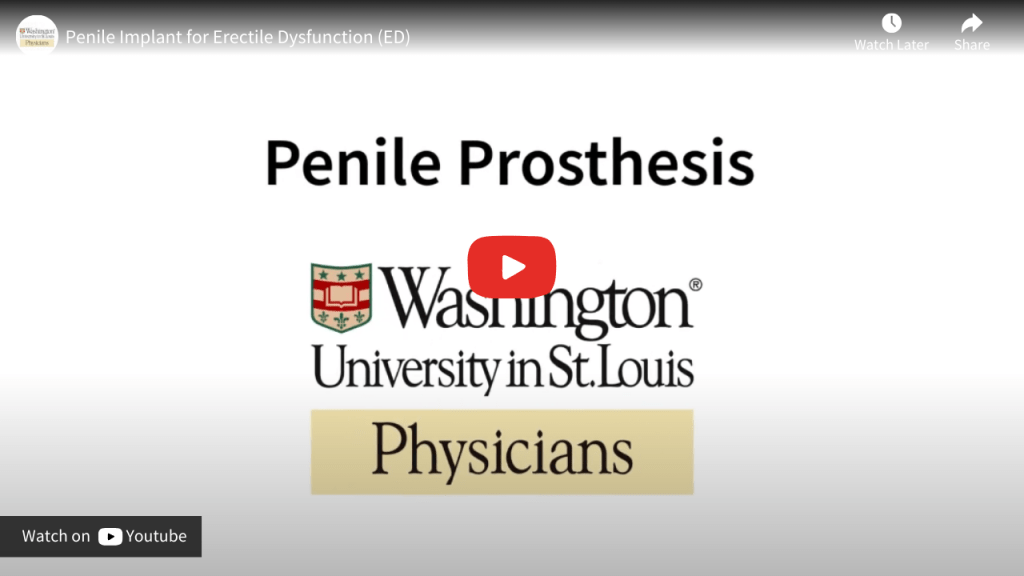Erectile dysfunction (ED) is very common, affecting more than 30 million men in the U.S. However, it is now possible to treat almost all men with ED.
Washington University urologists offer the complete spectrum of treatment options for men with erectile dysfunction (ED). Options range from pharmaceutical agents to injections, suppositories, vacuum devices, penile revascularization surgery, Peyronie’s disease surgery and penile prostheses that are surgically implanted. Our urologists have vast clinical experience with ED as one of the busiest and most experienced centers for implant surgery in the Midwest. We also offer a multidisciplinary approach, which employs the combined expertise of urologists, interventional radiologists, endocrinologists and psychologists when it comes to making a diagnosis and developing a treatment plan.
What causes ED?
ED is defined as the consistent inability to achieve an erection for satisfactory sexual intercourse. The vast majority of ED cases are the result of an organic, medical or physical problem such as high blood pressure, high cholesterol, diabetes, spinal injury, pelvic fracture, medication side effect, hormone disorders or problems related to prior pelvic surgery such as radical prostatectomy or rectal surgery.
Although uncommon, ED can also result from psychological conditions such as depression or anxiety.
How is ED treated?
Washington University urologists have a high success rate treating men who have ED with all levels of severity, ranging from mild to severe. Treatments offered are:
Surgical options:
- Prosthetic implant surgery. Several types of prostheses can be implanted in the penis. All are completely hidden from view, under the skin. Washington University urologists most often implant a three-piece inflatable prosthesis with fluid cylinders that can be completely filled, resulting in an erection, or completely emptied, resulting in a natural, non-erect (flaccid) state. A pump in the scrotum is used to inflate the penis. The three-piece inflatable implant has the most natural appearance, the greatest flexibility and a long track record of durability. The surgery is performed in a hospital with the patient under general anesthesia. A semi-rigid device, which can be bent upward or downward, is implanted in a small percentage of patients, who mostly have poor dexterity or are paraplegic, quadriplegic or not candidates for deep anesthesia.
- Penile revascularization surgery. ED that results in young people after a pelvic fracture can often be corrected with surgical transfer and sewing of an artery into the penis. If the distal penile arteries are still open, an epigastric artery from underneath the abdominal muscles can be transferred from the abdomen to the penis, vastly improving blood inflow and allowing a man to achieve more normal erections.
- Treatment for Peyronie’s disease. Severe penile curvature that precludes intercourse is a distressing condition. Our urologists have extensive experience in the medical and surgical correction of such penile deformities, including penile plication and plaque excision and grafting.

Non-surgical options:
- Pharmaceutical agents that increase blood flow to the penis before sexual activity. These are effective for approximately 70-80% of men with ED.
- Vacuum devices. These are external devices consisting of a cylinder, a pump and an elastic ring. A clear tube is placed over the penis, and suction is used to create an erection. The ring serves as a tourniquet at the base of the penis to maintain the erection.
- Urethral suppositories inserted into the urethra at the tip of the penis to enhance blood flow.
- Injection therapy. A syringe and needle – the same size as used by diabetic patients to inject insulin – are used to inject a blood vessel-dilating medicine into the side of the penis. The man develops an erection about 10-15 minutes after the injection. The goal is to create a rigid erection that lasts from 20 to 60 minutes. The dose is individualized for each patient.
What makes Washington University urologists unique in their treatment of ED?
- Extensive clinical and surgical experience
- Multidisciplinary approach toward determining ED cause including penile ultrasonography and Doppler, nocturnal penile tumescence sleep study (RigiScan®, NPT), penile angiography and cavernosography/cavernosometry
- Multidisciplinary approach to treatment
- World-class surgeons
Locations
Patients are seen at three locations:
- The Center for Advanced Medicine (Urologic Surgery Center on the 11th floor), located in the Washington University Medical Center in St. Louis.
- Barnes-Jewish West County Office Building (Suite 122) in west St. Louis County.
- Christian Hospital Northeast Professional Building #1 (Suite 202N) 11133 Dunn Road St. Louis, MO 63136
Urologic surgeons who treat ED: